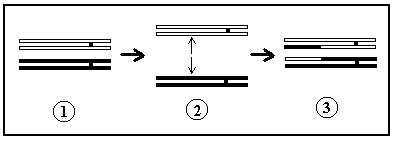
The question says "between the two linked loci." One can't answer
the question if the meaning of that isn't known (again, vocabulary).
The 2 linked loci here are the "Ee" and the "Gg" loci; those two loci are
on the same homologous chromosome pair. Assuming this much
isn't a problem, then we must know what "crossing over" means (again, vocabulary).
And it's probably necessary to be able to picture that in the mind, not
just write a definition of it. So here's a view, below, of what it
might look like. The duplicated homologous pair (the tetrad) is shown
in "1" below. Picture how this drawing correlates with the genotype
symbols given in the question. We'll suppose that the Ee and Gg loci
are both to the left of the centromere shown in #1. The crossover
event would involve a break between those two loci (that's what
the question said); so, let's say that the breaks occur at the arrows in
#2 below. [Of course, the 4 members of this tetrad would be
much closer together (touching, in fact, and maybe twisted around each
other) than shown in the drawing.] Then the actual crossover event
would result in the switching places of the chromosome segments shown in
#3. Therefore, 2 of the chromatids are now different; they represent
new combinations of alleles that were not present originally. NOTE
ALSO that the "outer" two chromatids are unchanged. So there are
4 different chromatids now in the tetrad. Without crossing over there
were only two genetically different chromatids: the solid white and
the solid black.

Next, we need to translate the drawing #3 back into the EeGg symbols, as shown below. Then we can proceed with the rest of meiosis to get the gametes. In the gametes we see that crossing over produces more gamete genotype combinations that were possible without crossing over.